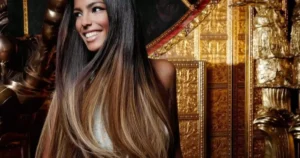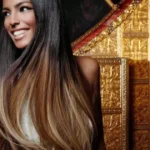African tribal colors refer to the distinctive and vibrant hues used in traditional clothing, body art, and cultural artifacts by diverse ethnic groups across the continent, reflecting rich cultural expressions and symbolic meanings.
Discover the vibrant tapestry of African cultural beauty secrets as we unravel the mystery behind the question: What did many African tribes color their hair with? Dive into the rich traditions of these diverse communities, where a single keyword unveils a world of tradition and expression. Join us on a journey where hair isn’t just strands but a canvas painted with heritage and pride.
Many African tribes traditionally colored their hair with natural materials found in their surroundings. One common practice involved using henna, a plant-based dye, to achieve various shades of red. Some tribes utilized mixtures of clay, plants, and even insects to create vibrant and symbolic hair colors, adding cultural significance to their distinctive hairstyles.
Cultural significance of hair in African tribes
Hair holds immense cultural significance in various African tribes, serving as a powerful expression of identity, status, and tradition. In many communities, intricate hairstyles convey a person’s age, marital status, and even social rank.
The artistry of braiding and weaving reflects a deep connection to heritage, with styles often passed down through generations. Some tribes believe that hair is a spiritual conduit, linking individuals to their ancestors and the divine.
Traditional methods of hair coloring

Traditional hair coloring methods have been around for centuries, and people have always found creative ways to change or enhance their hair color. One common method is using natural ingredients like henna or indigo to achieve various shades.
Another classic approach involves concocting mixtures with herbs, roots, or even kitchen items like tea or coffee. These methods not only add color but also nourish the hair. While the results may take longer to show compared to modern dyes, many appreciate the natural and gradual transformation these traditional techniques offer.
Popular natural ingredients
Natural ingredients are like the rockstars of the beauty and health world. Think of them as the cool kids everyone wants to hang out with. From soothing aloe vera to the zesty goodness of lemons, these ingredients are like nature’s own superstars.
They make your skin glow, your hair shine, and even keep you feeling healthy inside. It’s like getting the VIP treatment from Mother Nature herself!
Symbolism of hair colors
| Hair Color | Symbolism |
| Black | Mystery, Elegance |
| Brown | Stability, Natural |
| Blonde | Youth, Playfulness |
| Red | Passion, Boldness |
| Gray/Silver | Wisdom, Maturity |
| White | Purity, Innocence |
| Unconventional Colors (Blue, Pink, etc.) | Creativity, Individuality |
Significance of specific colors in different ceremonies and events
1.Understanding Cultural Symbolism: Colors hold unique meanings across different cultures. Research the significance of colors in the specific cultural context of the ceremony or event you’re attending.
2. Traditional Associations: Explore the traditional use of colors in ceremonies. For example, white may symbolize purity and new beginnings in some weddings, while red might represent luck and prosperity in certain cultural celebrations.
3. Emotional Impact: Consider the emotional impact of colors. Warm tones like red and orange may evoke feelings of excitement and energy, while cooler tones like blue and green can create a sense of calm and tranquility.
4. Theme Alignment: Connect the color choices with the theme of the ceremony or event. Whether it’s a joyous celebration or a solemn occasion, aligning colors with the overall theme enhances the visual and emotional experience.
5. Personal Preferences: Finally, take into account the personal preferences of those involved. Colors can hold individual significance, so incorporating preferred colors adds a personal touch to the ceremony or event, making it more meaningful for everyone involved.
Significance of specific colors in different ceremonies and events

1. Introduction to Modernization: Understand how modernization has introduced new technologies and techniques in the field of hair coloring. This includes advanced hair dyes, application methods, and tools that have replaced or modified traditional practices.
2. Chemical Composition Changes: Explore how modern hair dyes often contain different chemical compositions compared to traditional natural ingredients. This shift can impact both the coloring process and the effects on hair texture and health.
3. Application Techniques: Discuss the evolution of application techniques, such as the development of salon treatments, precision tools, and DIY kits. Modern methods may offer more convenience, precision, and a wider range of color options, impacting the way individuals color their hair.
4. Cultural and Social Influences: Examine how modernization has influenced societal norms and beauty standards related to hair coloring. Changes in fashion trends and media representation can play a significant role in shaping preferences for certain hair colors and styles.
5. Environmental Considerations: Consider the environmental impact of modern hair coloring practices compared to traditional ones. Modern products may have different sustainability profiles, and awareness of eco-friendly alternatives has become more prominent in recent times.
Modern African communities approach hair coloring
In many modern African communities, the approach to hair coloring has evolved into a vibrant and expressive form of self-identity. Aveda hair color has become a popular choice, offering a rich tapestry of colors that individuals use to adorn their hair with creativity and style. People embrace this brand for its diverse hues and innovative techniques, adding a unique touch to their personal expression.
From bold and bright hues to natural earthy tones, the choices are as diverse as the cultures themselves. Hair coloring is not just a fashion statement; it’s a celebration of individuality and cultural pride. It has become a way for people to express their creativity and uniqueness while staying connected to the rich traditions that shape their communities.
Preservation of cultural identity through hair coloring practices
Preserving cultural identity through hair coloring practices is a fascinating way for communities to express their unique traditions. Many cultures have specific beliefs, rituals, or historical significance attached to hair color.
By continuing these practices, people not only celebrate their heritage but also pass down stories and values to the next generations. Whether it’s using natural dyes or following traditional techniques, hair coloring becomes a living canvas reflecting the rich tapestry of cultural identity.
Frequently Asked Questions
What did many African tribes use to color their hair?
African tribes often used natural materials like henna, indigo, and plant extracts to color their hair.
Why did African tribes color their hair?
Hair coloring was a cultural practice, representing identity, status, and sometimes even spiritual beliefs within African tribes.
Were there specific meanings behind the hair colors used by African tribes?
Yes, different hair colors often held symbolic meanings, such as indicating age, marital status, or tribal affiliations.
Did the hair coloring practices vary among different African tribes?
Yes, there was diversity in hair coloring methods and materials used, reflecting the distinct traditions and customs of each tribe.
Is the use of natural materials for hair coloring still prevalent in African cultures today?
While modern methods exist, some African communities continue to value and practice traditional hair coloring with natural substances as a way to connect with their heritage.
Conclusion
The diverse African tribes showcased a vibrant array of hair coloring practices, each with its unique significance. From the use of natural elements like henna and indigo to symbolic patterns and styles, these traditions not only added a splash of color but also told stories of identity, rituals, and societal roles.
Exploring the materials and techniques used by many African tribes to color their hair unveils a rich cultural tapestry that reflects the deep connection between personal expression and communal heritage.











